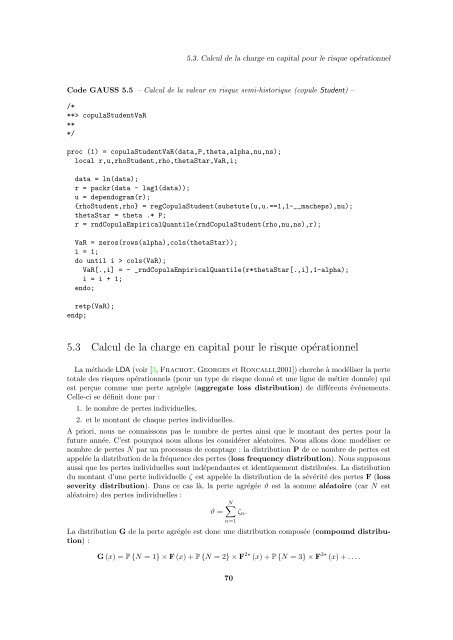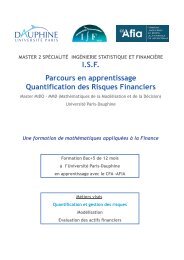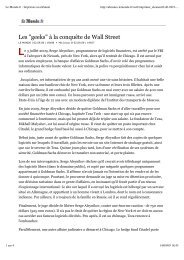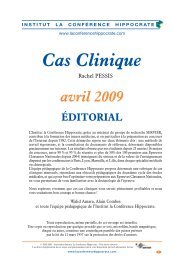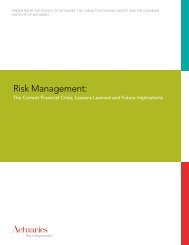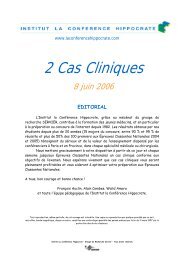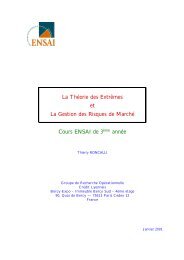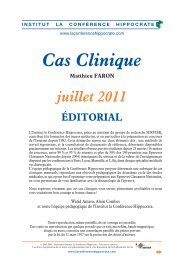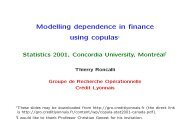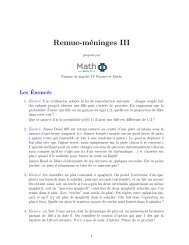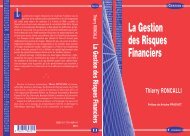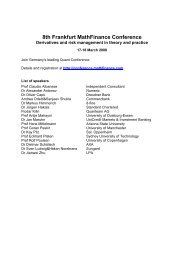Méthodes de Monte Carlo appliquées au pricing d ... - Maths-fi.com
Méthodes de Monte Carlo appliquées au pricing d ... - Maths-fi.com
Méthodes de Monte Carlo appliquées au pricing d ... - Maths-fi.com
You also want an ePaper? Increase the reach of your titles
YUMPU automatically turns print PDFs into web optimized ePapers that Google loves.
5.3. Calcul <strong>de</strong> la charge en capital pour le risque opérationnelCo<strong>de</strong> GAUSS 5.5 – Calcul <strong>de</strong> la valeur en risque semi-historique (copule Stu<strong>de</strong>nt) –/***> copulaStu<strong>de</strong>ntVaR***/proc (1) = copulaStu<strong>de</strong>ntVaR(data,P,theta,alpha,nu,ns);local r,u,rhoStu<strong>de</strong>nt,rho,thetaStar,VaR,i;data = ln(data);r = packr(data - lag1(data));u = <strong>de</strong>pendogram(r);{rhoStu<strong>de</strong>nt,rho} = regCopulaStu<strong>de</strong>nt(substute(u,u.==1,1-__macheps),nu);thetaStar = theta .* P;r = rndCopulaEmpiricalQuantile(rndCopulaStu<strong>de</strong>nt(rho,nu,ns),r);VaR = zeros(rows(alpha),cols(thetaStar));i = 1;do until i > cols(VaR);VaR[.,i] = - _rndCopulaEmpiricalQuantile(r*thetaStar[.,i],1-alpha);i = i + 1;endo;retp(VaR);endp;5.3 Calcul <strong>de</strong> la charge en capital pour le risque opérationnelLa métho<strong>de</strong> LDA (voir [3, Frachot, Georges et Roncalli,2001]) cherche à modéliser la pertetotale <strong>de</strong>s risques opérationnels (pour un type <strong>de</strong> risque donné et une ligne <strong>de</strong> métier donnée) quiest perçue <strong>com</strong>me une perte agrégée (aggregate loss distribution) <strong>de</strong> différents événements.Celle-ci se dé<strong>fi</strong>nit donc par :1. le nombre <strong>de</strong> pertes individuelles,2. et le montant <strong>de</strong> chaque pertes individuelles.A priori, nous ne connaissons pas le nombre <strong>de</strong> pertes ainsi que le montant <strong>de</strong>s pertes pour lafuture année. C’est pourquoi nous allons les considérer aléatoires. Nous allons donc modéliser cenombre <strong>de</strong> pertes N par un processus <strong>de</strong> <strong>com</strong>ptage : la distribution P <strong>de</strong> ce nombre <strong>de</strong> pertes estappelée la distribution <strong>de</strong> la fréquence <strong>de</strong>s pertes (loss frequency distribution). Nous supposons<strong>au</strong>ssi que les pertes individuelles sont indépendantes et i<strong>de</strong>ntiquement distribuées. La distributiondu montant d’une perte individuelle ζ est appelée la distribution <strong>de</strong> la sévérité <strong>de</strong>s pertes F (lossseverity distribution). Dans ce cas là, la perte agrégée ϑ est la somme aléatoire (car N estaléatoire) <strong>de</strong>s pertes individuelles :N∑ϑ = ζ n .n=1La distribution G <strong>de</strong> la perte agrégée est donc une distribution <strong>com</strong>posée (<strong>com</strong>pound distribution):G (x) = P {N = 1} × F (x) + P {N = 2} × F 2⋆ (x) + P {N = 3} × F 3⋆ (x) + . . . .70


